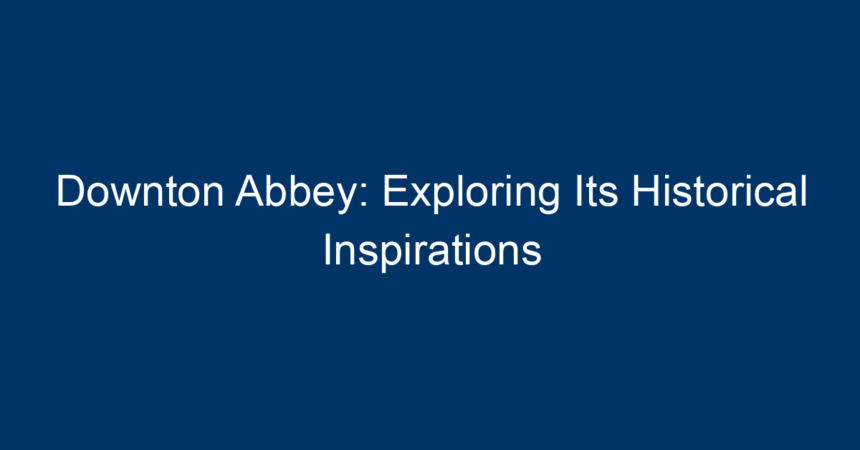Introduction
Downton Abbey is more than just a captivating television series; it is a rich tapestry woven with historical inspiration, showcasing the social and cultural dynamics of early 20th-century England. Created by Julian Fellowes, this beloved period drama has transcended the screen, captivating audiences worldwide. In this article, we delve into the historical inspirations behind Downton Abbey, examining its characters, events, and settings that mirror real-life history.
The Setting: A Glimpse into Edwardian and Post-War England
Architectural Influences
At the heart of Downton Abbey lies the eponymous estate itself, a stunning representation of Edwardian architecture—an era characterized by its grandeur and elegance. The series was primarily filmed at Highclere Castle, which has its roots dating back to the 8th century. This setting is not just a backdrop; it plays a pivotal role in portraying the social hierarchy of the time.
The grandeur of Downton Abbey mirrors the real-life estates of the English aristocracy, with large, ornate rooms that serve to highlight the lavish lifestyles of the nobility. Drawing parallels to actual historical houses, the diverse architectural features, from vast ballrooms to intimate libraries, encapsulate the lifestyle of the upper class.
Historical Context: War and Changes in Society
Set against the backdrop of World War I and its aftermath, Downton Abbey mirrors the significant changes in society during this tumultuous time. The war brought about profound shifts in social class, gender roles, and family structures. While the Crawleys represent the declining aristocracy, their household, featuring the diligent staff, showcases the emerging middle class gaining prominence in post-war Britain.
Historical precedents like the conflict’s impact on women’s roles are depicted vividly through characters such as Lady Edith and Lady Mary. Their journeys highlight the opportunities and challenges faced by women, aligning closely with the suffragette movement of the early 20th century.
The Characters: Inspired by Real Figures
The Crawley Family
The characters in Downton Abbey are richly layered and inspired by historical figures. The Crawley family, including the matriarch Countess Violet Crawley, reflects the attitudes and beliefs of their time. Countess Violet, portrayed by Maggie Smith, echoes the sentiments of many aristocratic women, balancing tradition with modernity—a struggle faced by real women of her social standing.
Servants and Their Stories
Not only does Downton Abbey shine a light on the lives of the aristocracy, but it also provides an unfiltered view of the servants’ experiences. Characters like Anna Bates and Thomas Barrow highlight the complexities of class divisions. The employment conditions and social norms depicted are reminiscent of the historical realities faced by domestic workers during the early 1900s.
Many of these characters draw inspiration from actual servants in great English estates, illustrating the often-overlooked narratives of those who kept these households running. The loyalty, struggles, and ambitions of the staff reveal the human stories behind the social curtain.
Key Historical Events: Integral to the Storyline
The Impact of World War I
World War I is a pivotal moment in Downton Abbey, shaping the lives of both the aristocracy and the lower classes. The series illustrates the personal losses experienced by the Crawleys—specifically, the sorrow of losing loved ones—and reflects historical figures like real-life soldiers who returned home changed and scarred by the war.
The war also leads to the temporary dissolution of strict class divisions as soldiers like Mr. Bates are portrayed as heroes, garnering respect that would not normally be afforded to individuals outside the aristocracy. This deviation from tradition provides a realistic depiction of societal change prompted by war.
The Spanish Flu Pandemic
Following the war, the Spanish Flu pandemic of 1918 serves as another historical backdrop in the series. The inclusion of this event adds a layer of realism as it further complicates the characters’ lives. Historical documentation from this era reveals that the pandemic affected millions globally, causing devastation and a shift in public health priorities.
Downton Abbey’s narrative captures the emotional toll on families, reminiscent of the true-life experiences of those who lived through this public health crisis, making the story relatable and poignant.
The Fashion: An Era of Transformation
Costume Design in Downton Abbey
Fashion is a significant element in Downton Abbey, transporting viewers to a time of elegance and style. The costume design reflects the evolution of fashion from the Edwardian period through the 1920s, portraying how societal shifts influenced clothing styles.
Characters evolve in attire, signifying their growth and the broader cultural changes. Lady Mary’s transition from Victorian-style dresses to the flapper style of the 1920s illustrates this movement beautifully. The show meticulously crafts costumes that draw inspiration from historical fashion trends, showcasing silhouettes, fabrics, and accessories that were prevalent during the era.
Symbolism of Clothing
In Downton Abbey, clothing also serves as a symbol of class distinction. The opulence of the Crawleys stands in stark contrast to the more practical attire of the servants, emphasizing the divide between the classes. This nuanced approach highlights the social order of the time, inviting viewers to examine the implications of attire in understanding class dynamics.
The Language: Period-Authentic Dialogue
Dialect and Dialogue
The language used in Downton Abbey captures the essence of early 20th-century Britain, with dialect and dialogue reflecting social class and education. The aristocracy speaks in a formal yet polished manner, while the dialogue of the servants is structured differently, revealing their social positioning.
Julian Fellowes’s attention to detail in dialogue elevates the show’s authenticity, as it provides insights into character backgrounds and societal expectations. Lines laced with wit and humor also echo the social interactions of the time, enabling viewers to immerse themselves fully in the world of Downton Abbey.
Conclusion: Downton Abbey as a Lens to History
Downton Abbey is not just an entertaining drama; it is a compelling representation of the historical tapestry of early 20th-century England. By intertwining elements of war, societal change, and class dynamics, the series invites audiences to reflect on the human experiences of a bygone era.
For viewers eager to explore this rich historical context further, several resources are available. Reading historical fiction or non-fiction books about early 20th-century England can deepen your understanding. Additionally, visiting historical sites like Highclere Castle can provide an immersive experience into the world that inspired Downton Abbey.
Engaging with the past through the lens of Downton Abbey not only entertains but educates, allowing us to appreciate the complexities of history and its impact on present-day society. Whether you are a historian, a fan of period dramas, or simply curious about the past, there is much to uncover within the enchanting world of Downton Abbey.




